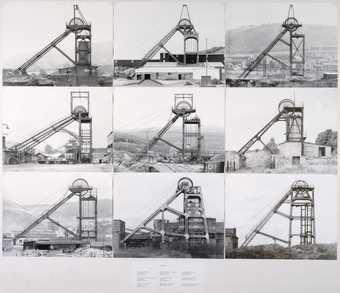
Bernd Becher and Hilla Becher
Pitheads
(1974)
Tate
I bet you’re thinking: ‘How can such matter-of-fact photographs of boring buildings be art?’
Don’t worry this is what lots of people thought when they first saw these photographs. But when you find out about Hilla Becher they make much more sense!
Who was she?
Hilla Becher was born in 1931 in Siegen, Germany. From a young age she was interested in photography so her mum (who was a photographer) bought her a really nice camera. Her first job was working as an assistant to a very old-fashioned photographer. He used ancient cameras and nineteenth century techniques. But rather than thinking 'Uh-oh get me out of here!' Hilla realised that she could learn a lot of useful skills from him. Which she did. She learnt how to take amazing, detailed photographs.
Hilla met Bernd Becher in 1959. He was a painting student fascinated by industrial buildings. But he didn't feel that paint could properly capture these fantastic structures. Luckily Hilla was on hand to help. She showed him how to take perfect photographs that captured every detail. From then on they collaborated: travelling around the world for the next 40 years and photographing over 200 industrial buildings including coal bunkers, winding towers, pitheads and factories.
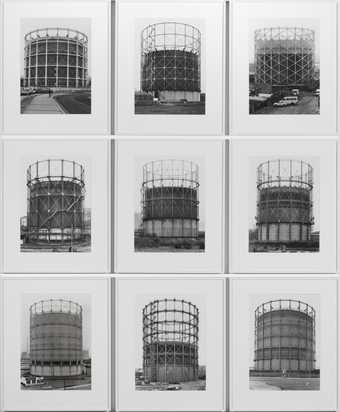
Bernd Becher and Hilla Becher
Gas Tanks
(1965–2009)
Tate
Why industrial buildings?
Hilla and Bernd loved the design of these buildings – as everything about them was functional. An exhibition of their photographs in 1969 was called Anonymous Sculptures. This tells us something about how they saw these structures. They saw them as huge sculptures with strong impressive shapes. The structures have been compared to minimalist sculptures such as those by Donald Judd. In fact people often refer to the Becher's photographs as sculptures!

Donald Judd
Untitled
(1972)
Tate
© Donald Judd Foundation/VAGA, New York and DACS, London 2024
But as well as showing us their hidden beauty, the Bechers wanted to make sure that the buildings are remembered. As, unlike sculpture, these structures are knocked down when they are no longer needed. In fact many of them have already disappeared.
How did Hilla and Bernd create their photographs?
Hilla and Bernd photographed each building in exactly the same way: always on cloudy days (so there were no shadows); always from the same angles; and always in black and white (and never with any people)! They then made groups of photographs that showed the same type of structure. By doing this they created a pattern of shapes and forms.
They loved the rhythm created by these groups, as Hilla said:
‘By placing several cooling towers side by side something happened, something like tonal music; you don’t see what makes the objects different until you bring them together, so subtle are their differences.’
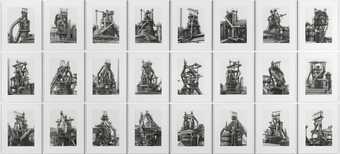
Bernd Becher and Hilla Becher
Blast Furnaces
(1969–95)
Tate
The point of photography is to ‘take a long look’ at something. And this is exactly what the Bechers’s photographs let us do. They don’t use arty effects or filters or unexpected angles. They just let the structures do the talking.
What did people think about their work?
At first other photographers and curators didn’t get the Bechers’ work and didn’t understand why it was art. But some of the greatest art can’t always be explained and people soon recognised that these photographs were extraordinarily beautiful. In fact Hilla and Bernd’s matter-of-fact ‘show it how it is’ style has inspired lots of contemporary photographers including Andreas Gursky and Thomas Struth.
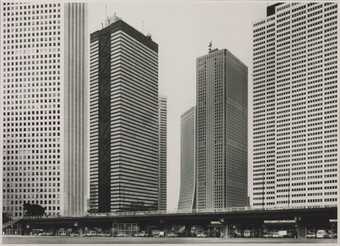
Thomas Struth
Shinju-ku (Skyscrapers), Tokyo 1986
(1986)
Tate
What do you think now?
You could say that Hilla and Bernd were doing exactly what we do when we take a photograph. They used photography to capture something amazing and awe-inspiring – and also recording and remembering.
Next time you see a huge old industrial building, take a long look. Is there anything beautiful or amazing about it? (Look at its shapes, its sheer size or perhaps a detail)? Photograph it…as it may not be there next time you’re passing!)
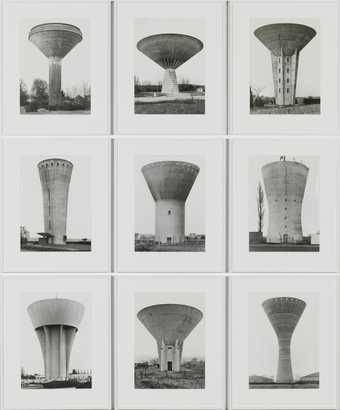
Bernd Becher and Hilla Becher
Water Towers
(1972–2009)
Tate

